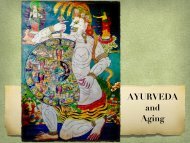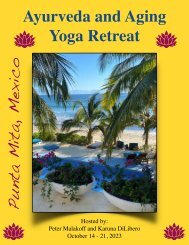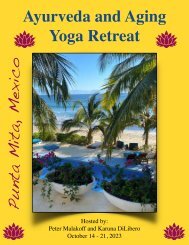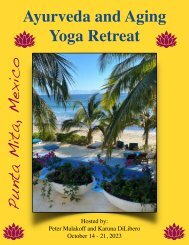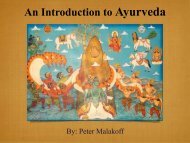How Thoreau's Walden Pond Mixed with the Ganges and Yoga Came to America with Swami Vivekananda
One early morning in 1846, during the coldest days of a New England winter, Henry David Thoreau looked out the window of his small cabin on Walden Pond and saw men cutting its ice into blocks. That ice was hauled by horse to a railroad that ran across the western edge of Walden Pond, packed into a boxcar, taken to Boston and loaded onto a clipper ship that sailed to Calcutta, India, arriving about four months later. Once there, that ice was purchased by grateful members of the East India Company. Thoreau had witnessed a small part of the global ice trade between New England and India that took place during the latter part of the nineteenth century. When Thoreau considered the ice trade, his vision sailed on metaphors far beyond the scope of business. The waters he imagined flowed both east and west and carried not just natural elements, but culture, religion and philosophy as well. He envisioned that after arriving in Calcutta, the New England ice of Walden Pond would eventually melt and run downhill where it would join with the sacred water of the Ganges. He wrote in Walden: "It appears that the sweltering inhabitants of Charleston and New Orleans, of Madras and Bombay and , drink at my well. In the morning I bathe my intellect in the stupendous and cosmogonal philosophy of the , since whose composition years of the gods have elapsed, and in comparison with which our modern world and its literature seem puny and trivial; and I doubt if that philosophy is not to be referred to a previous state of existence, so remote is its sublimity from our conceptions. I lay down the book [Bhagavad-Gita] and go to my well for water, and lo! there I meet the servant of the Bramin, priest of and and who still sits in his temple on the Ganges reading the , or dwells at the root of a tree with his crust and water jug. I meet his servant come to draw water for his master, and our buckets as it were grate together in the same well. The pure Walden water is mingled with the sacred water of the Ganges." This book tells the story of these waters . . .
One early morning in 1846, during the coldest days of a New England winter, Henry David Thoreau looked out the window of his small cabin on Walden Pond and saw men cutting its ice into blocks. That ice was hauled by horse to a railroad that ran across the western edge of Walden Pond, packed into a boxcar, taken to Boston and loaded onto a clipper ship that sailed to Calcutta, India, arriving about four months later. Once there, that ice was purchased by grateful members of the East India Company. Thoreau had witnessed a small part of the global ice trade between New England and India that took place during the latter part of the nineteenth century.
When Thoreau considered the ice trade, his vision sailed on metaphors far beyond the scope of business. The waters he imagined flowed both east and west and carried not just natural elements, but culture, religion and philosophy as well. He envisioned that after arriving in Calcutta, the New England ice of Walden Pond would eventually melt and run downhill where it would join with the sacred water of the Ganges. He wrote in Walden: "It appears that the sweltering inhabitants of Charleston and New Orleans, of Madras and Bombay and , drink at my well. In the morning I bathe my intellect in the stupendous and cosmogonal philosophy of the , since whose composition years of the gods have elapsed, and in comparison with which our modern world and its literature seem puny and trivial; and I doubt if that philosophy is not to be referred to a previous state of existence, so remote is its sublimity from our conceptions.
I lay down the book [Bhagavad-Gita] and go to my well for water, and lo! there I meet the servant of the Bramin, priest of and and who still sits in his temple on the Ganges reading the , or dwells at the root of a tree with his crust and water jug. I meet his servant come to draw water for his master, and our buckets as it were grate together in the same well. The pure Walden water is mingled with the sacred water of the Ganges."
This book tells the story of these waters . . .
You also want an ePaper? Increase the reach of your titles
YUMPU automatically turns print PDFs into web optimized ePapers that Google loves.
Asanas<br />
Asanas or “bodily postures” are said <strong>to</strong><br />
have been developed by <strong>the</strong> ancient<br />
Rishis of India <strong>and</strong> are practiced for a variety<br />
of reasons. Conducive <strong>to</strong> health <strong>and</strong><br />
a sister science of Ayurveda, many practice<br />
asanas for <strong>the</strong> purpose of well-being<br />
alone. Asana practice has become so<br />
popular in <strong>the</strong> West that it is thought <strong>to</strong><br />
represent <strong>the</strong> classical ancient vidya or science<br />
of <strong>Yoga</strong>. <strong>How</strong>ever, this is not <strong>the</strong> case. ( for an excellent book on this subject<br />
read: <strong>Yoga</strong> Body: The Origins of Modern Posture Practice, by Mark Single<strong>to</strong>n)<br />
<strong>Yoga</strong> is one of <strong>the</strong> six-systems of Indian Philosophy created by <strong>the</strong> Rishi Patanjali.<br />
Referred <strong>to</strong> as <strong>the</strong> “<strong>Yoga</strong> Sutras” or Ashtanga <strong>Yoga</strong> (eight limbed <strong>Yoga</strong>), Asana<br />
is mentioned in <strong>the</strong> <strong>Yoga</strong> Sutras as one of <strong>the</strong> limbs or angas in which <strong>Yoga</strong><br />
is <strong>to</strong> be established, let me briefly describe <strong>the</strong>m:<br />
In <strong>the</strong> <strong>Yoga</strong> system of Patanjali, <strong>the</strong> whole world is divided in<strong>to</strong> different interconnected<br />
spheres <strong>and</strong> <strong>the</strong> eight limbs of Ashtanga <strong>Yoga</strong> refer <strong>to</strong> <strong>the</strong>m individually.<br />
The first two limbs are Yama (Do not’s) <strong>and</strong> Niyama (Do’s) which refer <strong>to</strong> <strong>the</strong><br />
sphere of life lying outside <strong>the</strong> body. When <strong>Yoga</strong> is established here, <strong>the</strong> moral<br />
<strong>and</strong> ethical qualities such as purity of thought, contentment, spiritual effort, devotion<br />
<strong>to</strong> God, non-violence, truthfulness, non-stealing, not entering in<strong>to</strong> debt,<br />
celibacy, patience, moderation in all things <strong>and</strong> steadiness are established.<br />
The third <strong>and</strong> next limb is asana. This is <strong>the</strong> realm of <strong>the</strong> body itself. Patanjali<br />
says that <strong>Yoga</strong> is established in <strong>the</strong> body when <strong>the</strong> following qualities are found:<br />
sthira sukham asanam – one should be steady <strong>and</strong> comfortable in asanas (<strong>Yoga</strong> Sutras:<br />
2.46). That is <strong>the</strong> complete mention of asana in <strong>the</strong> <strong>Yoga</strong> Sutras. In <strong>the</strong><br />
<strong>Yoga</strong> Sutras, <strong>the</strong> purpose of asana is not for itself alone or merely for health, but<br />
<strong>to</strong> offer a stable bodily foundation for meditation on <strong>the</strong> Divine. But, even here<br />
<strong>the</strong>re need not be obsessive concern.<br />
Ramana Maharshi, <strong>the</strong> great Advaitic sage of <strong>the</strong> 20 th century was asked<br />
about what asana should be used <strong>to</strong> sit in meditation:<br />
Q: Should I sit in a particular posture [asana] <strong>and</strong> sit on a grass mat?<br />
M: Stability in <strong>the</strong> Self [Atman] is <strong>the</strong> real asana. Be steady in that asana. In<br />
what asana will Atman sit? It is wrong <strong>to</strong> say that <strong>the</strong>re is no Self-knowledge <strong>with</strong>out<br />
asanas. Atman has no need of <strong>the</strong>m. The compulsion of having a particular<br />
kind of asana makes <strong>the</strong> mind get agitated.<br />
The o<strong>the</strong>r limbs of <strong>the</strong> eight limbed system are briefly as follows, going from<br />
grosser <strong>to</strong> subtlest:<br />
Pranayama – <strong>the</strong> limb of <strong>the</strong> breath<br />
Pratyadhara – <strong>the</strong> limb of <strong>the</strong> senses<br />
Dharana – <strong>the</strong> limb of <strong>the</strong> mind<br />
Dhyana – when <strong>the</strong> mind flows like oil being poured from one container <strong>to</strong><br />
<strong>the</strong> o<strong>the</strong>r<br />
Samadhi – when <strong>the</strong>re is no difference between <strong>the</strong> medita<strong>to</strong>r, <strong>the</strong> object of<br />
mediation <strong>and</strong> <strong>the</strong> process of meditation<br />
These eight limbs are all interconnected. This is why <strong>the</strong>y are called angas or<br />
limbs. If you pull one leg of <strong>the</strong> chair <strong>the</strong> o<strong>the</strong>r three come along <strong>with</strong> it. The<br />
dynamic working principal is that <strong>to</strong> whatever degree <strong>Yoga</strong> is found in any one<br />
of <strong>the</strong>se limbs, yoga is established in all of <strong>the</strong>m – <strong>to</strong> <strong>the</strong> same extent. The great<br />
Rishis spent little time <strong>with</strong> <strong>the</strong> grosser limbs, based on <strong>the</strong>ir observation that it is<br />
more effective <strong>to</strong> change everything by working at <strong>the</strong> subtler or subtlest level of<br />
creation since <strong>the</strong> subtle is at <strong>the</strong> root of <strong>the</strong> gross <strong>and</strong> <strong>the</strong> causal is at <strong>the</strong> root of<br />
<strong>the</strong> subtle . . . Like spokes coming in<strong>to</strong> <strong>the</strong> hub of a wheel. Therefore <strong>the</strong>y concentrated<br />
<strong>the</strong>ir teachings on <strong>the</strong> Realization of <strong>the</strong> Divine (Samadhi) <strong>and</strong> not on<br />
<strong>the</strong> asanas.<br />
<strong>How</strong>ever, <strong>the</strong>re have always been those who tried <strong>to</strong> pull <strong>the</strong> legs of <strong>the</strong> chair<br />
through hatha-yoga or <strong>the</strong> gross <strong>and</strong> subtle exercise of <strong>the</strong> body. Most people in<br />
<strong>the</strong> West <strong>to</strong>day, practice <strong>Yoga</strong> asanas for <strong>the</strong>ir health benefits alone <strong>and</strong> “<strong>Yoga</strong> asanas”<br />
have been divorced from <strong>the</strong>ir original context of a God-Realizing Spiritual<br />
practice.<br />
Related Glossary Terms<br />
Hatha <strong>Yoga</strong>, <strong>Yoga</strong>, Yogendra Mastamani<br />
Index Find Term<br />
Chapter 1 - <strong>How</strong> <strong>Thoreau's</strong> <strong>Walden</strong> <strong>Pond</strong> <strong>Mixed</strong> <strong>with</strong> <strong>the</strong> <strong>Ganges</strong> <strong>and</strong> <strong>Yoga</strong> <strong>Came</strong> <strong>to</strong> <strong>America</strong> <strong>with</strong> <strong>Swami</strong> Vivekan<strong>and</strong>a<br />
Chapter 1 - <strong>How</strong> <strong>Thoreau's</strong> <strong>Walden</strong> <strong>Pond</strong> <strong>Mixed</strong> <strong>with</strong> <strong>the</strong> <strong>Ganges</strong> <strong>and</strong> <strong>Yoga</strong> <strong>Came</strong> <strong>to</strong> <strong>America</strong> <strong>with</strong> <strong>Swami</strong> Vivekan<strong>and</strong>a<br />
Chapter 1 - <strong>How</strong> <strong>Thoreau's</strong> <strong>Walden</strong> <strong>Pond</strong> <strong>Mixed</strong> <strong>with</strong> <strong>the</strong> <strong>Ganges</strong> <strong>and</strong> <strong>Yoga</strong> <strong>Came</strong> <strong>to</strong> <strong>America</strong> <strong>with</strong> <strong>Swami</strong> Vivekan<strong>and</strong>a<br />
Chapter 2 - The Kashi Yatra, <strong>the</strong> Spiritual Master <strong>and</strong>!<strong>the</strong> Living Water of Life







